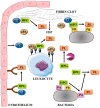The Recruitment and Activation of Plasminogen by Bacteria-The Involvement in Chronic Infection Development
- PMID: 37445613
- PMCID: PMC10341603
- DOI: 10.3390/ijms241310436
The Recruitment and Activation of Plasminogen by Bacteria-The Involvement in Chronic Infection Development
Abstract
The development of infections caused by pathogenic bacteria is largely related to the specific properties of the bacterial cell surface and extracellular hydrolytic activity. Furthermore, a significant role of hijacking of host proteolytic cascades by pathogens during invasion should not be disregarded during consideration of the mechanisms of bacterial virulence. This is the key factor for the pathogen evasion of the host immune response, tissue damage, and pathogen invasiveness at secondary infection sites after initial penetration through tissue barriers. In this review, the mechanisms of bacterial impact on host plasminogen-the precursor of the important plasma serine proteinase, plasmin-are characterized, principally focusing on cell surface exposition of various proteins, responsible for binding of this host (pro)enzyme and its activators or inhibitors, as well as the fibrinolytic system activation tactics exploited by different bacterial species, not only pathogenic, but also selected harmless residents of the human microbiome. Additionally, the involvement of bacterial factors that modulate the process of plasminogen activation and fibrinolysis during periodontitis is also described, providing a remarkable example of a dual use of this host system in the development of chronic diseases.
Keywords: bacterial infection; enolase; fibrinolysis; periodontal disease; plasmin; plasminogen.
Conflict of interest statement
The authors declare no conflict of interest.
Figures




Similar articles
-
Exploitation of plasmin(ogen) by bacterial pathogens of veterinary significance.Vet Microbiol. 2015 Jul 9;178(1-2):1-13. doi: 10.1016/j.vetmic.2015.04.008. Epub 2015 Apr 17. Vet Microbiol. 2015. PMID: 25937317 Review.
-
Bacterial plasminogen receptors utilize host plasminogen system for effective invasion and dissemination.J Biomed Biotechnol. 2012;2012:482096. doi: 10.1155/2012/482096. Epub 2012 Oct 14. J Biomed Biotechnol. 2012. PMID: 23118509 Free PMC article. Review.
-
Multifunctional interaction of CihC/FbpC orthologs of relapsing fever spirochetes with host-derived proteins involved in adhesion, fibrinolysis, and complement evasion.Front Immunol. 2024 Apr 25;15:1390468. doi: 10.3389/fimmu.2024.1390468. eCollection 2024. Front Immunol. 2024. PMID: 38726006 Free PMC article.
-
Interaction of spirochetes with the host fibrinolytic system and potential roles in pathogenesis.Crit Rev Microbiol. 2016 Aug;42(4):573-87. doi: 10.3109/1040841X.2014.972336. Epub 2015 Apr 27. Crit Rev Microbiol. 2016. PMID: 25914944 Review.
-
Fibrinolysis: the key to new pathogenetic mechanisms.Curr Med Chem. 2008;15(9):923-9. doi: 10.2174/092986708783955455. Curr Med Chem. 2008. PMID: 18473800 Review.
Cited by
-
The Pneumococcal Protein SufC Binds to Host Plasminogen and Promotes Its Conversion into Plasmin.Microorganisms. 2023 Dec 12;11(12):2969. doi: 10.3390/microorganisms11122969. Microorganisms. 2023. PMID: 38138113 Free PMC article.
-
ENO1/Hsp70 Interaction Domains: In Silico and In Vitro Insight for a Putative Therapeutic Target in Cancer.ACS Omega. 2025 Jan 30;10(5):5036-5046. doi: 10.1021/acsomega.4c10808. eCollection 2025 Feb 11. ACS Omega. 2025. PMID: 39959117 Free PMC article.
-
Structure, Function, and Regulation of LytA: The N-Acetylmuramoyl-l-alanine Amidase Driving the "Suicidal Tendencies" of Streptococcus pneumoniae-A Review.Microorganisms. 2025 Apr 5;13(4):827. doi: 10.3390/microorganisms13040827. Microorganisms. 2025. PMID: 40284663 Free PMC article. Review.
-
Pathogenicity and virulence of Yersinia.Virulence. 2024 Dec;15(1):2316439. doi: 10.1080/21505594.2024.2316439. Epub 2024 Feb 22. Virulence. 2024. PMID: 38389313 Free PMC article. Review.
References
Publication types
MeSH terms
Substances
LinkOut - more resources
Full Text Sources

